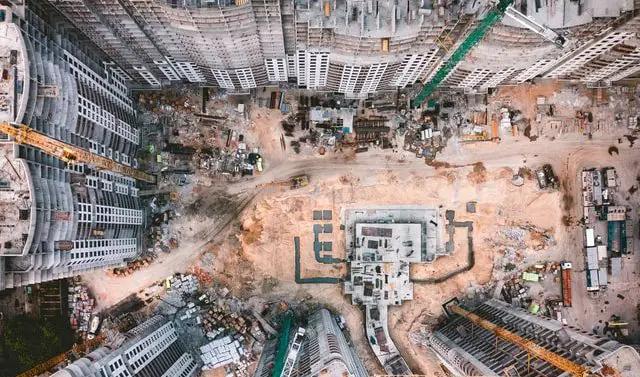For many years, the demand for building services has been steadily increasing. As a result of this need, the industry has been looking for new ways to meet consumer demands. Construction companies can now use technology to help them meet these market requirements.
In this article, we will be looking at the various technologies used by construction companies and their trends, pros, and cons.
How Does Technology Affect Construction?
Technology affects the construction industry in many ways. Some of the most promising solutions are augmented reality, exoskeletons, drones, artificial intelligence, construction robots, and wearables. It helps to make construction safer, more cost-effective, and more sustainable.

6 Construction Technologies and Trends
Let’s take a look at some of the technology that have influenced how work is done on construction sites.
1 | Augmented Reality
AR is a technology that ensures that a construction professional gets as much information as possible concerning any part of a structure.
For example, a worker at the construction site can point an AR-enabled tablet towards a wall and get all the details, such as the building plan used to create the wall. In this case, AR will make the building plan seem like part of the physical environment.
AR provides timely measurements of physical places, highlights places where changes are required, and updates workers at the construction site of any safety precautions on a timely basis.
Likely, AR will no longer use computers or tablets to perform its tasks in the future. AR will most likely use mere eyeglasses in its operations. As a result, AR technology will enable construction professionals to access information freely at all times.
2 | Construction Exoskeletons
Construction exoskeletons refer to wearable machines with motorized joints. These machines provide extra support during repetitive lifting, bending, and grabbing.
The origin of these devices can be traced to rehabilitation programs. They have gradually become famous for increasing workers’ efficiency at the construction site and shielding them from injuries.
Some exoskeletons use electricity as their power source, while others help redistribute weight in the entire body. Therefore, these devices help construction workers in handling tough jobs.
There are different types of exoskeletons, namely:
- Shoulder Support Exosuits
These are commonly used for lifting tasks. Exosuits reduce the weight on workers’ shoulders, thus keeping them from fatigue. - Back Support Exosuits
This suit ensures that one doesn’t strain when lifting heavy objects. The exoskeleton fits the shoulders, back, and waist. - Crouch Support Exosuits
The Crouch support exosuit acts as a chair and fits your legs. This exoskeleton will help you crouch for long periods without feeling tired.
Construction exoskeletons are also available in full-body models. These models reduce fatigue and ensure you are strong during heavy lifting tasks. There are many benefits of construction exoskeletons. However, the industry has its eyes on using robots in the future to further help with complex and risky tasks.
3 | Drones
Drones are the little gadgets you see flying through the air, performing inspections or simply recording activities. These devices are fitted with a tiny camera that quickly monitors large pieces of land. Another advantage of drones is reducing the expenses incurred in a variety of manual processes. They have produced excellent results for the building sector, and this is projected to continue in the years ahead.
Here are some of the areas that have embraced drone technology:
- Security
Construction sites are full of building materials and equipment that cost a fortune. Drones help monitor the worksite to ensure the valuables are not stolen, harmed or destroyed. - Equipment Tracking
A drone can also be used to track misplaced equipment within a construction site. - Mapping
Mapping is among the initial steps in the building of structures. Drones help with mapping by quickly surveying large pieces of land at minimal costs. They are known to reduce mapping costs by 95%.
Personnel safety, site inspections, and the preparation of progress reports all benefit from the use of drones. As a result, this technology will be around for a long time. Enhanced machine learning and artificial intelligence will be one of the ways in which drone technology improves in the future.

4 | Artificial Intelligence and Machine Learning
Artificial Intelligence (AI) refers to the ability of technology to make decisions without being helped by a human being. On the other hand, machine learning refers to the power of technology to learn from extensive data analysis and past experiences. Both technologies have had a significant impact on the construction sector.
Here are some of the ways through which AI and machine learning are changing worksites:
- Machine learning helps to improve workplace safety. It analyzes workplace photos to see if there are places with possible safety violations or risks.
- Machine learning analyzes past projects to identify problems and proposes better timelines.
- Machine learning creates superior designs since it can evaluate a variety of choices.
Recent AI and machine learning trends indicate that these two technologies will have a greater impact on the construction business. As a result, there’s a likelihood that the two technologies will work together to support construction projects from start to finish.
5 | Construction Robots
Many construction companies have yet to completely adopt robots on their sites. However, utilizing robots is one approach to help react to the current global pandemic. Because these robots can perform many human duties, they will keep the construction site from becoming overcrowded.
Here are some of the construction robots used today:
- Factory Robots
These robots carry out simple manufacturing tasks. - Collaborative Robots
Collaborative robots help workers in heavy jobs like carrying equipment or tools. - Fully Autonomous Robots
These robots scan the environment and perform complex tasks using tools without human help.
According to research done by Statista, the global construction robot market size stood at 85.3 million U.S dollars in 2021 and is expected to increase to 242.4 million U.S dollars by the year 2030.
6 | Construction Wearables
Construction wearables enhance the safety of workers as well as increase their productivity. The construction site is one of the riskiest places to work. The dangers present here range from falls or being hit by construction tools and equipment. Construction wearables protect workers from dangers that can lead to injuries or even death.
Some of the construction wearables include:
- Smart Hard-Hat
This hat can sense brainwaves which helps it detect microsleeps. The cap protects a worker from possible injuries. - Smart Boots
These boots are fitted with sensors. They can detect any risk facing a person, such as being hit by an oncoming vehicle. - Power Gloves
Power gloves add strength to the hands of a construction worker. They protect the hands from wearing off and from getting injured.
Other construction wearables like goggles, monitors, and smartwatches check fatigue and aid in contact tracing. The construction industry aims to equip all its workers with intelligent security devices to enhance their safety and productivity at the job site.
Pros of Technology in Construction
Here are some of the beneficial ways that technology has influenced construction in recent years.
Efficient daily operations
It wasn’t easy in the past for construction firms to create and share design information promptly. Designers and other professionals would perform most of their functions manually, such as sketches, project illustrations, and outlines. These experts would then send such items to the appropriate stakeholders for approval via long routes.
On the other hand, today’s project managers use construction technology tools to share digital sketches, coordinate projects, and receive rapid input from many stakeholders throughout the world. This innovation thanks to technology has made a significant difference in the way businesses operate. Construction technology has also made sharing information within departments or clients easier.
Long-Lasting and Smarter Structures
Here are the two ways through which construction technologies are producing better buildings
- Designing more durable and long-lasting buildings from the beginning by utilizing market research tools and Building Information Modeling (BIM)
- Working on existing buildings to improve their durability for the future with the use of AI analytics software and digital twins
Designers, engineers, and builders work together to produce great structures from scratch to completion. The team shares ideas freely amongst themselves to create superior work. In addition, technology ensures time and resources are not wasted with poorly done buildings.
Older buildings are also benefiting from modern construction technologies. For example, older structures are being upgraded to have improved lighting systems, HVAC, and fire safety systems.
Using Technology to Create Better Tools
Better tools produce better work. Here are some examples of improved tools as a result of technology:
- Building Information Modeling (BIM) with its 3D imaging provides more interactive models
- Estimating systems help save construction costs and can suggest changes made to the project
- Laser scanning facilitates efficient developments, renovations and demolitions
Improved Customer Services
Clients get timely information without necessarily going to the construction sites. They can review the quality and standards of their structures from wherever they are.
Innovation
Construction technologies are known to promote innovations. Therefore, professionals in this field are constantly looking for better ways to meet construction needs.

Cons of Technology in Construction
While technology brings many advantages to the construction industry, there are some challenges and downsides that must be kept in mind.
High Upfront Costs
Some construction technologies are expensive. As a result, most small businesses can’t afford these technologies.
Costly Implementation Procedures
Construction companies incur additional expenses when implementing new technology. For example, the staff that will be trained on using the different technologies.
Workforce Reduction
Most construction companies are replacing some of their employees with technology. As a result, the well-being of those losing their jobs is affected negatively.
Conclusion
Construction technology has improved how buildings are being planned, designed, and built. It has increased the revenues of construction firms by using better estimation methods and improved customer satisfaction. The staff at the site can also benefit from safer working conditions thanks to smart wearables and support technologies. Furthermore, sharing work-related information has become faster and easier.
If you want to learn more about smart buildings, PropTech, smart cities, and sustainability, feel free to take a look at our other articles.
